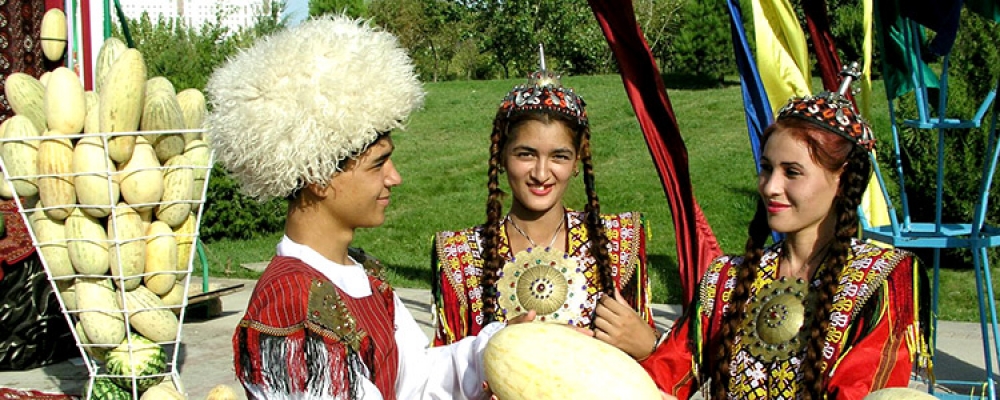The best and most of Central Asia
This 21-day, three-country tour is designed for people eager to have the most comprehensive possible experience of Central Asia. On it, we'll spend 10 days in Uzbekistan, four days in the neighbouring republic of Turkmenistan, and the rest of the time in Iran, also known today, as it was in ancient history, as Persia.
Over the centuries, our part of the world has been conquered so often, and by so many nationalities, that just trying to keep track of them all is a challenge. In the 9th and 10th centuries, much of the territory we'll explore was part of the old Persian empire. During that period, in fact, Bukhara was considered to be the cultural and spiritual heart, not only of Persia but also of the entire Islamic world. Earlier, Alexander the Great and Arab invaders held sway over the region. Later, various parts of Central Asia would be dominated by nomadic Oghuz Seljuk tribes, the ancestors of present-day Turkmen; Mongols under Genghis Khan; Tamerlane, who made Samarkand his imperial capital; Uzbek tribes whose native tongue was a dialect of Turkish but who admired Persian culture so greatly that they adopted Persian as their court language; Imperial Russia; and finally, the Soviet Union. And that's just the short list!
All our conquerors left behind evidence of their presence in the form of sites now being excavated by archaeologists, our unique regional languages that have borrowed words from many larger linguistic groups, and some of the most breathtaking Islamic architecture in the world.
After we've escorted you through the highlights of Uzbekistan and Turkmenistan, we'll cross the border into Iran. On this leg of the tour, we start by visiting Mashhad, Iran's holiest city, with a huge shrine complex devoted to the 817 martyrdom of Shia Islam's eighth Imam, Reza. Other cities on our tour include Shiraz, Iran's cultural capital; Isfahan, famed for its magnificent architecture; Kashan, home to a garden considered to be the one of the most beautiful in the world; and finally the nation's capital, Tehran.
Day 1: Tashkent
After your flight lands in our nation's capital, you'll be picked up at the airport and driven to your hotel to rest up after your long journey. Today you’ll see Tashkent's thoroughly modern side but after breakfast today, you'll get another perspective on a city whose history goes back about 2,500 years. In 1966, a devastating earthquake destroyed much of Tashkent, including many ancient landmarks. Restoring those masterpieces of medieval Islamic architecture to their former glory took decades but we think you'll agree that the spectacular results speak for themselves. Two of the Old City's most magnificent 16th century showpieces include the Kukeldash and Barak-Khan Madrassahs. Other stops on our tour include the State Art Museum; the Museum of Decorative and Applied Arts; and Chorsu Bazaar.

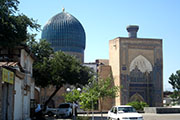
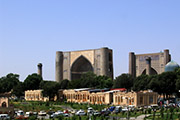
Day 2: From Tashkent to Samarkand
After breakfast, we'll set out for Samarkand, a four-hour drive from Tashkent, and check into our hotel there. After lunch, prepare to be dazzled by the splendour of a city which is often called one of architectural wonders of the world. In 1370, Tamerlane decided to make Samarkand his imperial capital. To that end, he brought in the greatest artisans and craftsmen from all over his vast empire to turn his dream into reality.
Today's Samarkand is believed to be very close to Tamerlane's vision but photographs taken in the early 20th century show these monumental buildings in an advanced state of disrepair, the elaborate tilework all but gone in many places. In recent years, massive restoration projects have transformed the interiors and exteriors of mosques, madrassahs and mausoleums and this work is still in progress.
A number of colourful legends surround the story of the creation of the Mosque of Bibi-Khanum, one of Samarkand's architectural highlights, but the most credible is that Tamerlane ordered it built and named it after his favourite wife, a Mongolian princess.
Today, you'll also get the chance to pay your respects to Tamerlane himself, where he rests, along with various relatives, under the golden dome of the fabulous Gur-i Amir mausoleum.
Our tour allows time to explore another of Samarkand's claims to fame -- the city's excellent main bazaar.
Day 3: More Samarkand
Today, we turn our attention to some of Tamerlane's relatives. The most famous of them, Ulugh Beg, was a grandson who ruled over the lands known as Transoxiana from 1409 to 1449. Today, though, he is remembered mainly as an astronomer and a great patron of the sciences. He established the Ulugh Beg Observatory, a three-storey, cylinder-shaped building constructed around three huge astronomical instruments. The largest of these, a curving stone arch called the Fakhri sextant, was used to measure the angle of elevation of celestial bodies, allowing astronomers to calculate the length of a year to within 25 seconds – almost 200 years before telescopes were invented! After Ulugh Beg's death, the observatory was destroyed by religious fanatics but rediscovered in 1908 by Russian archaeologist Vassily Vyatkin. This discovery meant so much to Vyatkin that he asked to be buried on the site.
We will also visit the Shakh-i-Zinda necropolis, a complex consisting of mosques and eleven mausoleums constructed in the 14th and 15th centuries to house the remains of members of the royal family and other nobles. More ancient tombs, including one believed to hold the remains of the Old Testament prophet Daniel, exist in the nearby town of Afrasiab. In the afternoon, we'll visit a workshop and see hand-weaving of silk carpets.
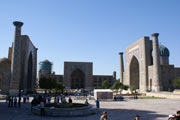


Day 4: Samarkand – Shahrisabz – Samarkand
After breakfast, we'll board the bus for a day trip to Tamerlane's birthplace, Shakhrisabz (also spelled Shahrisabz and Shakhrisyabz), all versions meaning “green city.” Tamerlane was so fond of his home town that under his and his successors' patronage in the 14th and 15th centuries, it became the region's cultural and political hub. In 1380, Tamerlane sent to Shakhrisabz some of the master artisans he'd imported from around his empire and there, they created his Ak-Sarai Palace.
Like most of the grand buildings and monuments you'll visit on this tour, Ak-Sarai Palace has been designated a UNESCO World Heritage site. The Paris-based United Nations agency has this to say about it: “Although Samarkand may boast a great many Temurid monuments, not one can rival the Ak-Sarai Palace in Shakhrisyabz. The foundations of its immense gate have been preserved: this architectural masterpiece is outstanding in its dimensions and bold design.”
We'll also visit the mausoleum complex where Jehangir, Tamerlane's eldest and favourite son, who died at the age of 22, is buried.
On the subject of royal burial places: in 1943, archaeologists discovered an underground chamber near this mausoleum complex which contained only one large stone vault inscribed with Tamerlane's name. Understandably, this can, and has, generated confusion – wait a minute, isn't Tamerlane buried in Gur Amir in Samarkand? While the short answer is yes, the longer one is more interesting.
Among the theories: Tamerlane may once have intended to be buried in the city of his birth and therefore ordered a crypt constructed for that purpose but at some point, changed his mind. Another version: in the winter of 1405, when Tamerlane died suddenly of pneumonia in Kazakhstan, all the mountain passes that would have led to Shakhrisabz were blocked by ice and snow so his body was taken to Samarkand instead.
But here's the problem: Tamerlane's Shakhrisabz crypt should have been empty but wasn't -- it contained the remains of two unidentified men. So, if we're talking about Shakhrisabz, “Who's buried in Tamerlane's tomb?” isn't a silly question -- because the only correct response to it is “Nobody knows.”
In early evening back to Samarkand, check into our hotel and have dinner.

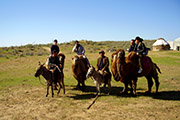
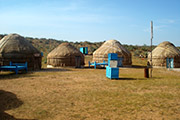
Day 5: Samarkand to Nurata
After breakfast, we'll set out for our three-hour drive to the city of Nurata. In addition to Alexander the Great's fortress there, our sightseeing tour will include a sacred shrine complex constructed around a spring (called a chashma), teeming with trout, whose water is believed to have healing properties.
After lunch with an Uzbek family, we'll proceed to a Kazakh yurt camp deep in the desert. There, you'll mount camels for a ride to the shores of Aydarkul Lake. We'll have dinner back at the camp and after breakfast the next morning, set out for the next leg of our tour – Bukhara.
Did you know? While Uzbekistan is known for our fabled oasis cities, 80 percent of our country's territory consists of open desert.



Day 6: Bukhara via Gijduvan and Vabkent
From the yurt camp to Bukhara is a three-hour drive but along the way, we'll stop in Gijduvan, the centre of Uzbekistan's ceramic arts, to have lunch with the family of a ceramicist and watch how our country's unique pottery is created.
We'll also pause in the town of Vabkent, a short distance outside Bukhara, to view a 12th century minaret. Like most of our country's ancient monuments, this little-known minaret has been also designated a UNESCO world heritage site. When monuments are given this designation, it means that they are protected in perpetuity by international law.
Day 7: Bukhara Sharif
Since Emir Travel and Hotel Emir are both in Bukhara, we freely admit to a bias in favour of our ancient city, once one of the most renowned centres of learning and culture in the Islamic world. One of the greatest charms of our Old City is that almost everything worth seeing and experiencing, including shops, restaurants, covered bazaars and of course, our monumental buildings, is within easy walking distance.
Sharif meaning 'noble' in Arabic, is a designation bestowed only on a handful of cities, Mecca and Medina among them, with special religious importance in Islam. Bukhara earned its sharif status as the 9th century birthplace of Imam al-Bukhari, one of the greatest collectors of written hadith -- sayings or anecdotes attributed to the Prophet Muhammad. For generations before al-Bukhari`s lifelong work, these stories had only been passed down orally.
Today, you'll see the majestic Kalyan minaret, the symbol of our city, the prototype for the smaller, slimmer Vabkent minaret you saw the previous day. Although it was built in 1121, after Bukhara was sacked by Genghis Khan and his army in a century later, legend has it that the Mongol emperor was so impressed that he ordered it spared while everything else around it was destroyed, including the original mosque. The mosque and the madrassah now facing each other across the square both date from the 16th century.
Some time in the 1800s, one of Bukhara's cruelest emirs, Nasrullah Khan, ordered a man charged with defacing the minaret to be thrown from the top of it. However, our historians say that there's no truth to the widely-believed “Tower of Death” story that executions such as this took place regularly. After all, five times every day, a muezzin had to climb up and down the 104 steps of the interior spiral staircase to summon the faithful to prayer. KhojaevHouse In Soviet times, Bukhara downplayed the most poignant historical aspect of a residence that used to be known only as “a rich merchant's house.” In fact, the merchant who once owned it, a dealer in the pelts of karakul sheep (called Persian lamb in the West), was the father of Faizullah Khojaev, who was a controversial figure to Bukharans. Khojaev, the leader of a dissident group that helped the Red Army overthrow the last emir of Bukhara in 1920, became the first president of what was then called the Bukharan People's Soviet Republic.
But like many other people of his day, Khojaev ran afoul of Joseph Stalin and, after a show trial in Moscow, was executed by firing squad on March 13, 1938, his 42nd birthday. His mother, sister, wife and daughter were all exiled to a prison camp in Siberia, although his mother died enroute. Khojaev was rehabilitated in 1966 and today, the house where he once lived now contains much of his personal and family memorabilia. While there, you'll also see displays of the traditional clothing worn by Uzbek people before the 1920 revolution, including paranjas, the all-obscuring veil that Bukharan women were required to wear in public.
Day 8: More to admire about Bukhara
Today, we begin our tour with a visit to the Ark Fortress Museum. This massive structure, known to have existed in some form for more than 2,000 years, has suffered a great deal of damage over the years, most recently after a buildup of ice and snow caused part of the roof over the entrance to collapse. But before the revolution, the Ark was the centre of government for the entire emirate of Bukhara and also housed the main palace of the last emir of Bukhara, Said Alim Khan. Today, the rooms open to the public house historical displays.
Some of the area of Registan Square in front of the Ark had to be sacrificed when roads were widened, so it used to be much larger. Here, Bukharans used to gather to watch entertainments such as wrestling, jugglers, trapeze artists – as well as public floggings and executions.
Sites of interest near the fortress include the remains of the walls that used to encircle the city, with doors that were closed, locked and barred to all non-residents after dark; the Bolo-Khauz complex, consisting of a reservoir, mosque and minaret; and the intriguing Chashma-Ayub (Job's Well) shrine and mausoleum.
According to legend, long ago, the prophet Job, whose tale of terrible suffering is told both in the Old Testament and the Qur'an, once visited what is now Bukhara during a drought. Distressed to learn that the people here didn't have enough drinking water, Job drove his staff into the ground, causing a stream of clean, clear water burst forth. Tamerlane ordered the construction of this building in the 14th century and local people still come here to collect the spring water, which is believed to have healing properties.
One of the oldest of Bukhara's monuments is the Samanid mausoleum, built between 892 and 943, to house the remains of Ismail Samani, an emir who ruled in Central Asia, and a few of his relatives.
The goodies on offer in our main bazaar, also in this immediate area, are likely to whet your appetite for lunch (if you haven't already ruined it by overindulgence in samples of the merchandise). In the afternoon, we'll visit the summer palace of the last emir of Bukhara, not far outside the city. Although this site had been used as a country estate by many previous emirs, this palace was completed in 1918, which allowed Alim Khan only two short years to enjoy it. There, you'll also see an exhibition of hand-made suzani.
In late afternoon, in the courtyard of the Divan Begi madrassah, an Uzbek Folklore emsemble will perform for you, followed by dinner.
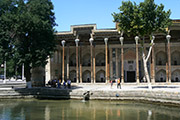
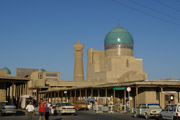
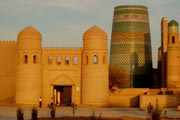
Day 9: From Bukhara to Khiva
The drive through the Kyzyl-Kum desert from Bukhara to Khiva takes six to seven hours so we'll leave right after breakfast but stop by the Amu-Darya River, called the Oxus in ancient times, for a picnic lunch. After you check into your Khiva hotel, you'll have dinner and the rest of the evening will be yours.
Day 10: A walking tour of Khiva
Unlike Tashkent, Samarkand and Bukhara, Khiva's old city is almost uninhabited. With 54 perfectly-preserved or restored historical buildings and monuments, including mosques, madrassahs, mausoleums, minarets and palace complexes in so compact an area, it's almost like experiencing Samarkand in miniature. Highlights of the city include an underground mosque, the courtyard of the royal harem – and the unique symbol of the city, called Kalta Minor, meaning “short minaret,” which looks like an elaborately-decorated industrial chimney.
If this minaret had ever been finished, it might have been taller than Bukhara's Kalyan minaret and, according to one of several tales associated with it, this might even be the reason why it wasn't finished. Historically, the khans of Khiva and the emirs of Bukhara were both rivals for influence in the region and mortal enemies whose armies habitually waged war on each other. Allegedly, Khiva's Muhammad Amin Khan, who had ordered the construction of this minaret, intended for it to tower over Bukhara's minaret but when Bukhara's then-emir Nasrullah – the same emir, nicknamed “the Butcher,” who had ordered a man to be thrown to his death from the the Kalyan minaret -- got wind of this, he vowed it would never happen.
As the story goes, Nasrullah offered the minaret's architect more money if he'd abandon that project and build his mighty minaret in Bukhara – and the architect agreed. But when the Khivan khan found out about this double-cross, he put a contract out on the architect's life, who fled to save his own skin. Since there was no one else who could complete the job, work on the minaret ceased after the death of the Khivan khan in 1860, so what you see today is exactly what it looked like then.
Did you know? It's a long story with no short version but much of the decorative work in Khiva's summer palace complex was done by a colony of Mennonite artisans who lived in a nearby village called Ak Metchet and whose direct descendants now live in North America. Look for the exquisite parquet floor, carved doors and the huge bed that they constructed for the Khan of Khiva's Nurullabai Palace.
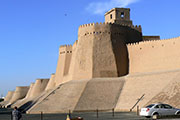
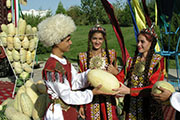
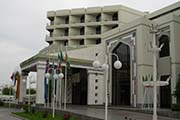
Day 11: Khiva - Urgench - Dashogus - Ashgabat
After breakfast drive to the border with Turkmenistan, cross the border and head for the town KunyaUrgench, the ancient seat of Central Asian civilization, which is located in present day Turkmenistan. Among the ruins you will find the TurabegKhanum Mausoleum, the KutlukTimur Minaret, the tallest in Central Asia, and the Sultan Ali Mausoleum. In evening take a flight to Ashgabad, the capital of Turkmenistan. Grand Turkmen Hotel
Day 12: Ashgabat
Recently Ashgabat has seen a boom in new construction, initiated by the former president Saparmurat Niyazov and funded with oil and gas revenues. Today’s tour includes visits to the new mosque, the local bazaar “Tolkuchka”, the Museum of Carpets and Textiles and Nartional Museum. In the afternoon, visit a farm of Akhal-Teken horses.
Day 13: Ashgabat - Merv - Ashgabat
Fly to ancient Merv for a full-day exploration of the ruins of its five ancient cities. The remains of Merv were listed as a UNESCO World Heritage site because of the wealth of ongoing information they provide about the evolution of urban centers. Return to Ashgabat in the evening.
Day 14: Nisa
This morning, visit the ancient ruined city of Nisa, the capital of the Parthian Empire, dating back to the 3rd century BC. This evening, celebrate your journey to Central Asia with a festive farewell dinner.
Day 15: Ashgabat - Bajgiran – Meshed
Arrival at Bajgiran border, Transfer to Mashad for rest. Evening visit Holy Shrine of Imam Reza and Mashad Bazaar. Overnight in Mashad
Day 16: Meshed - Shiraz
Excursion to Toos, visit: Haroonieh and Ferdows tomb, back to Mashad. fly to Shiraz (direct flight only available on Sat, Mon, Wed, Fri), transfer to hotel, overnight in Shiraz.
Day 17: Meshed – Shiraz
City tour of Shiraz to visit Eram garden, Vakil mosque & Bazaar, Nasirolmolk mosque, Hafez & Sa’adi tombs, overnight in Shiraz.


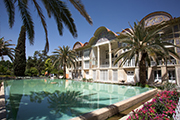
Day 18: Shiraz - Isfahan
Drive to Isfahan, en route visit Persepolis & Pasargadae, evening visit of Isfahan bridges, overnight in Isfahan.
Day 19: Isfahan
City tour of Isfahan to visit Chgehel Sotoun palace, Imam square, Imam & Sheikh Lotfollah mosques, Aliqapou palace & Bazaar, overnight in Isfahan.
Day 20: Isfahan - Tehran via Kashan
Drive to Tehran via Kashan, visit Fin Garden and one of the old houses in Kashan, proceed to Tehran, farewell dinner in an Iranian traditional restaurant with live music, over night in Tehran.
Day 21: Tehran
Transfer to IKA airport for departure flight.

